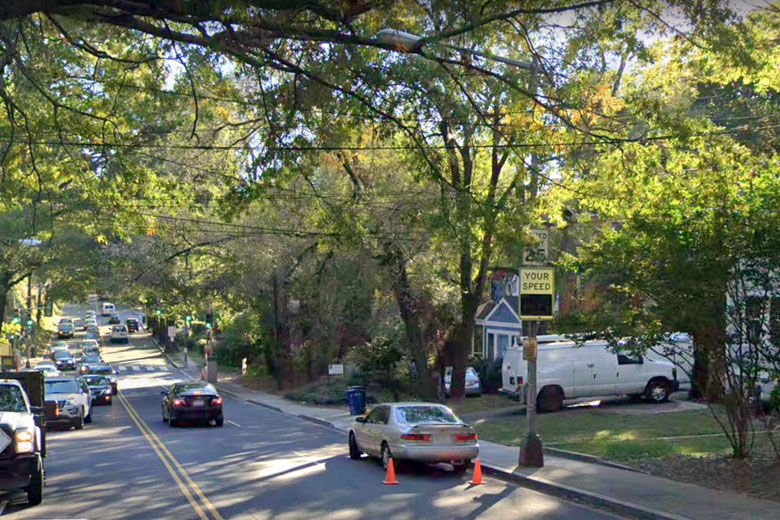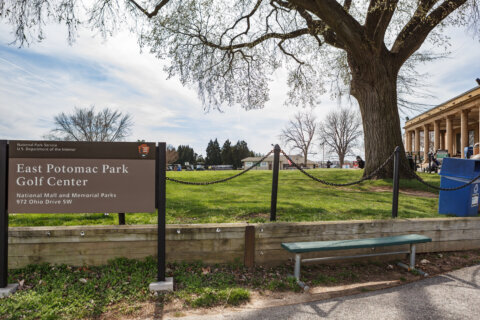When one Maryland driver got a $100 speeding ticket from the D.C. Department of Motor Vehicles in 2019, he didn’t grudgingly pay the fine like hundreds of thousands of drivers around the D.C. area do every year. He decided to fight it — and he took his case all the way to the District’s highest court.
In a decision issued last month, the D.C. Court of Appeals ruled in the man’s favor — and the decision could make it easier for other drivers to dispute D.C. tickets going forward.
The case, which took three years to make its way through the courts, hinged on whether the District can enforce the speed limit in areas where posted signs are blocked by trees or otherwise obscured. The appeals court said no — a potential headache for the District as it seeks to enforce tickets issued by dozens of speed cameras across the city.
“My only interest here is in fairness,” John Galbreath, the Maryland man who successfully challenged the ticket, told WTOP. “The District’s previous practices were unfair. I hope that this will make the practices more fair.”
The District’s Department of Transportation is still reviewing the court’s decision, according to an emailed statement from Director Everett Lott.
But Lott said the department has already begun a citywide inspection of speed limit signs, opening up thousands of work orders to improve sign visibility and trim tree limbs.
Not everyone is celebrating the court’s ruling.
“This opinion strikes me as creating a lot of mischief,” said Ward 3 Council Member Mary Cheh, who chairs the Transportation and Environment Committee.
“This is an open door to challenge any automated traffic enforcement speed ticket if (you) can get a picture of a sign that looks like it was obscured,” she said.
Cheh, who is leaving office at the end of her term in January, suggested the council could clarify the District’s traffic regulations to effectively nullify the appeals court’s decision.
“But we are where we are,” she said. “And this is the opinion — and until something happens, this is the law in the District of Columbia.”
‘What’s the right thing here?’
The case started in March 2019, when Galbreath, who lives in Baltimore County, got a $100 ticket in the mail. A speed camera had clocked a Ford Fusion registered to the Bright Ideas Co. — the small firm Galbreath owns — going 36 mph on a leafy, four-lane stretch of Military Road in Northwest D.C. where the speed limit is 25.
Galbreath pulled up the intersection on Google Street View and discovered the speed limit sign near 29th Street and Military Road was, as he would later argue in one of his appeals, “mounted extraordinarily high on the pole” and “obscured by tree branches.”

Galbreath, who happens to be an attorney, decided to fight the ticket. Those tree branches would form the crux of his legal challenge: The speed limit sign was illegible and, therefore, not properly posted.
Galbreath took his case first to the D.C. DMV, then to a three-member review board that hears ticket disputes, then to D.C. Superior Court. (Technically, he wasn’t representing himself but his company, to which the car was registered.)
Each time, though, he lost. The DMV, it turned out, had an automatic fallback for quashing potential challenges: The default speed limit.
Under D.C. traffic regulations, officials are not required to post the speed limit on every street — and where no speed limit signs are posted, drivers have to abide by the default speed limit. (At the time, the default was 25 mph; it has since been lowered to 20 mph).
DMV officials argued, and the D.C. Superior Court judge agreed, that even if the sign on Military Road was obscured, Galbreath should have observed the default 25 mph speed limit. According to their reasoning, an obscured sign was the same thing as no sign.
In D.C. “if you do not know what the posted speed limit is, the law requires you to travel at 25 mph,” the DMV examiner said in the original decision denying Galbreath’s challenge.
After losing in Superior Court, Galbreath had only one more chance to challenge the ticket: the D.C. Court of Appeals, which is the District’s highest court.
Galbreath said the idea of simply giving up his legal fight “didn’t even enter my mind … I only have to ask myself one question: What’s the right thing here?”
Court’s decision
Cases involving simple traffic infractions rarely make it to the appeals court — the written opinion called them “vanishingly rare” — because the time and resources necessary to lodge a challenge are generally more of a hassle than simply paying a fine.
By the time the appeals court heard the case in October 2021, Galbreath was raising a broad legal challenge to the District’s traffic enforcement efforts, saying the city was operating its speed cameras in violation of the U.S. Constitution.
The court sidestepped that argument and decided the case more narrowly, based on D.C. traffic regulations. The court concluded that the DMV was improperly interpreting its own rules in its efforts to ticket Galbreath.
According to the court’s decision, D.C. can continue to rely on the default speed limit on streets with no signs posted. But once a speed has been posted, “then that speed limit cannot be enforced against a driver if the speed limit sign is obscured or blocked,” the court wrote, saying that to require drivers to revert to the default speed limit in such cases “gives rise to a host of absurdities.”
For example, under the District’s interpretation of traffic laws, if the speed limit on a stretch of road had been posted as 45 mph but the sign somehow became obscured, the speed limit automatically becomes 20 mph. A driver going 51 mph could be ticketed not for going 6 mph over the limit, but 31 — a traffic offense that could result in 90 days in jail.
The bottom line, according to the court decision: If drivers ticketed for speeding can show a speed limit sign was somehow unreadable, they have grounds to have their ticket dismissed.
‘It is not about one ticket’
It’s unclear how many future tickets could be affected by the court’s ruling.
The District has been steadily adding speeding cameras across the city over the past several years. There are now 92 of them, with plans to add more.
In just the first half of the fiscal year, D.C. issued more than 485,000 tickets based on images captured by speed cameras — generating more than $47 million in revenue. About 4,800 tickets — and more than $517,000 in fines — came from the camera on Military Road at the center of Galbreath’s case.
During oral arguments, Mary Wilson, an attorney with the D.C. Office of the Attorney General, told the three-judge panel that the issue at the heart of Galbreath’s case — enforcing the default speed limit as a fallback — didn’t regularly come up at the D.C. DMV.
“You’re telling me I can’t find another speed limit sign in this town that’s obscured?” an incredulous D.C. Court of Appeals Associate Judge Joshua Deahl said.
Wilson replied, “This case is about one ticket —”
“No, it’s not! No, it is not,” Deahl interrupted. “It is not about one ticket. It’s about whether or not the District can use a default regulation to say if you can’t read a sign, the speed limit is 20 mph.”
The D.C. lawyer also came in for withering questioning over a surprise move.
After the case had already been set for oral arguments, the District suddenly moved to have the case dismissed and refund Galbreath’s fine, which he had since paid, in an attempt to “moot out” the case. That would have prevented the Court of Appeals from taking it up.
The three-judge panel of judges — all former public defenders — declined to drop the matter, concluding the District’s lawyering was an attempt to avoid having the court issue an unfavorable opinion.
“The rarity of these challenges in this court gives the District a strong incentive to try to evade review,” the court said in its written opinion. “There is little upside if it wins ($100) and potentially enormous downside if a precedent-setting loss upsets its established enforcement practices on a grand scale.”
What now?
D.C. officials said they’ve already kicked off a major effort to make sure signs are visible.
Last fiscal year alone, DDOT responded to more than 17,000 service requests “for various tree-related matters related to sign visibility,” Lott, the DDOT director, said in the statement to WTOP.
During the initial round of citywide inspections that began last summer before the court had even handed down its decision, crews opened up 4,000 work orders to make speed limit signs more visible, including replacing signs and trimming tree branches.
The sign inspections will continue through the rest of D.C. next year, said Lott, who encouraged drivers to contact 311 to report any speed limit or parking signs that are faded or blocked by trees.
In a separate statement, Gabriel Robinson, the director of the D.C. DMV, said his agency would provide additional training to examiners about how to handle cases where ticketed drivers present evidence that a speed limit was unclear or obscured.
Cheh, the outgoing D.C. Council member, said she believed the court’s decision could snowball into a series of other legal challenges.
For example: How much of a sign has to be obscured before a ticket can be thrown out?
“How much is illegible?” Cheh said. “Is it like a little bit? One branch? Two branches? Do you have to really strain to see what the sign is?”
And another scenario: “What if when you first got on Military Road, there was a sign of 25 mph, perfectly clear, at the proper height and, in every way, good,” Cheh hypothesized. “And then, along the way … the government posted yet another sign, but this one was obscured. So now what? You can just ignore the whole thing and go as fast as you want until you get to a sign that’s properly visible?”
There are also safety concerns.
During oral arguments, the D.C. lawyer suggested blocking D.C. from enforcing the default speed limit on streets where posted signs are blocked would give drivers the green light to go any speed they liked.
“The way your honor is reading the regulations, you could go 80 on Military Road if the sign is blocked,” said Wilson, the D.C. attorney.
But the court’s written opinion said that’s incorrect because existing regulations already mandate that drivers cannot go “at a speed greater than is reasonable and prudent under the conditions” regardless of the posted sign.
“I am not blind to the safety issue at all,” Galbreath told WTOP. “The correct balance between safety and fairness is to just reliably post the speed limits.”








